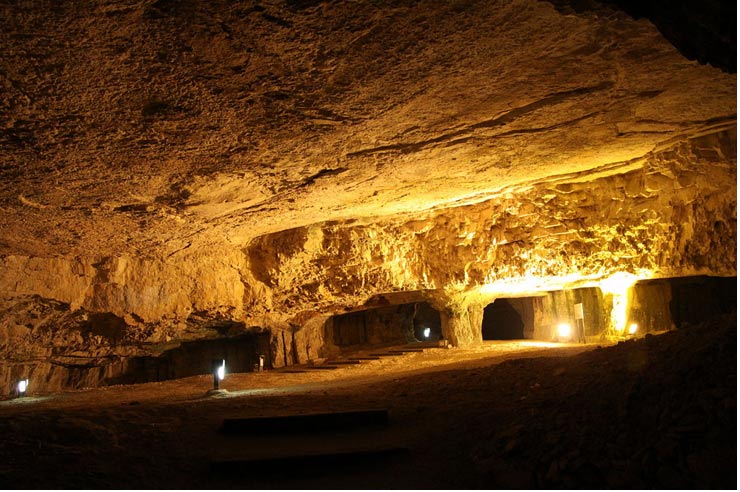Cave of Zedekiah: The Secret Grotto of Jerusalem
For over 300 years, Zedekiah’s Cave was the stuff of legend, another story out of Jerusalem. However, one day in the winter of 1854, American missionary James Turner Barclay was walking his dog with his son along the outskirts of the city. Suddenly, the dog, in hot pursuit of a fox, sifted through some dirt alongside the Old City wall and disappeared through an opening in the earth. Barclay called to the animal, whistling to it, but there was no response. His son continued searching at the foot of the rocky cliffs and came upon a deep reservoir created by the flow of water from recent rainfall. Peering inside, he heard barking emanating from the depths of the earth. The next day, Barclay and his son, returned to the site and slipped through the opening only to discover an ancient man-made cave that had been lost by time. Dating back thousands of years, the cave had originally been used as a quarry. Today it is considered one of the most revered sites in Freemasonry.

Zedekiah's Cave, Jerusalem, Israel (Wikimedia Commons)
The Location and Size of Zedekiah's Cave
Zedekiah’s Cave (or Solomon's Quarries) is the largest man-made cave in Israel. There are quite a few underground reservoirs in Jerusalem but this one is much bigger than any other known underground cavity. The entrance is not far from the Damascus Gate in Jerusalem and lies under the Muslim Quarter continuing until the Via Dolorosa in the Christian Quarter just north of the Temple Mount. The mouth of the cave is situated on a rocky cliff that serves as the foundation for the Old City wall.
The cave today is large, but it was once much larger, and spanned beyond the walls all the way to the area of the Garden Tomb. A 20,000 square-meter underground limestone quarry, the cavern extends about 200 meters (650 feet) from its entrance. It is roughly 100 meters (330 feet) in width, with a depth of more than 9 meters (30 feet) below street level. Although it is thought that the cave was carved over a period of several thousand years, no one knows exactly how old it is.

Entrance to Zedekiah's Cave, Jerusalem Israel (Wikimedia Commons)
A Cave of Many Names
Zedekiah’s Cave is its Hebrew name, while King Solomon’s quarry is its name in English, and the Cave of the Kings is what it is called by the Arabs. Josephus Flavius, in his book Wars of the Jews (against the Romans), refers to the cave as the "Royal Caverns." The name originated from the “Melekeh" or "Royal" limestone quarried in it. This later led to the cave being called "King Solomon's Quarries."
- Ten Amazing Caves of the Ancient World
- The Dark Reputation of the Dunmore Cave of Ireland
- Lovelock Cave: A Tale of Giants or A Giant Tale of Fiction?
Ancient Quarry
Zedekiah's Cave is the most important of Jerusalem's ancient quarries and its importance lies in the fact that the major quarry layers consist of “Melekeh” stone. When first quarried, Melekeh stone looks glistening white. Its exposure to the sun turns it grayish in color (similar to Italian marble) and creates an excessive hardness which becomes harder with the passage of time. Many Jerusalem monuments have been constructed using this type of limestone with the most well known site being the Temple Mount.
Suleiman the Magnificent (1494–1566), was an Ottoman sultan who mined the quarry, then sealed it up around 1540 due to security concerns. During the renovation of its city walls, Zedekiah's Cave was blockaded with stones, so that it would not be a weak link in the city's fortifications. The last known documented use of the cave as a stone quarry is connected with the construction of a clock tower above Jaffa Gate.

The clock tower at Jaffa Gate, (1908-1918) (Wikimedia Commons)
This took place in the early 20th century when the Turks built several clock towers throughout Israel with a clock being built over the main entrance to the city in 1908. The stones of this clock tower were quarried in Zedekiah's Cave which was the last time it was used as a quarry. The clock was removed by the British Mandate during the 1920s. Also, during the British Mandate, stones were quarried from Zedekiah’s Cave and sent to various countries to serve as cornerstones for newly erected Masonic Lodges.
Zedekiah's Tears for Jerusalem
In the lowest, innermost part of the cave is a tiny spring trickling through the ceiling known as “Zedekiah’s tears”. Zedekiah was Jerusalem’s last biblical king and by all accounts put into power by the Babylonians. During his reign, the Babylonians invaded and conquered Jerusalem, exiling all the Jews.
It is believed Zedekiah attempted to flee Jerusalem to Jericho through this cave but was captured and brought before the Babylonian King Nebuchadnezzar. His sons were murdered in front of him and his eyes were gouged out. Thus, the spring represents his tears, but not over his sons, but of the fall of Jerusalem.

Nabuchodonosor Has Zedekiah's Children Killed before his Eyes (1787), Fabre (Wikimedia Commons)
The Freemasons and Zedekiah's Cave
The Freemasons believe that Solomon was the first and greatest mason and that their origins come from the workers at Solomon’s temple in Jerusalem. Therefore, they regarded Zedekiah’s Cave as an appropriate location to hold their secret ceremonies. In 1868, the first meeting of Freemasons in Ottoman Palestine was held by candlelight here. To this day, an annual ceremony is held in the auditorium-like chamber.
- Enigmatic symbols and carvings in man-made cave in England confound experts
- The Intriguing Carvings of Rosslyn Chapel
- Chronicles from the Future: A True Story Kept Hidden by the Masons now Revealed
- Forgotten Stones: Secrets of the Megalithic Quarries
The Temple Mount: Created by stones from Zedekiah's Cave?
Though more than 150 years have elapsed since its discovery, much of the cave's history still remains shrouded in mystery. Nevertheless, there is consensus on one point: this artificial, man-made structure provided Jerusalem's builders with an excellent quarry for the stones used in the construction of the city's major public properties. The cave is located close to the Temple Mount, where large stones could have been transported to the Temple construction site. Furthermore, it is known from the First Book of Kings that it was forbidden to use any iron tools in the actual 'on site' construction of the Temple.
Zedekiah’s Cave would have been the ideal spot for quarrying and dressing the stones for the Temple, while meeting these requirements. It is also thought by some that the stone structure in the cave is identical to the stone remnants preserved from King Solomon's Temple.

The Dome of The Rock Mosque, in the temple mount, Jerusalem, Israel (Wikimedia Commons)
Another legend says that when Rome placed Jerusalem under siege, the priests hid materials and instruments from the temple deep down inside Zedekiah’s cave.
If this is true, more treasures have yet to be discovered.
Featured Image: Zedekiah's Cave, Jerusalem, Israel (Wikimedia Commons)
By Bryan Hill
References
"CITYsights: Jerusalem's Underground Scene Uncovered." The Jerusalem Post. August 3, 2011. http://www.jpost.com/Video-Articles/Video/CITYsights-Jerusalems-underground-scene-uncovered
Herman, Israel. "Freemasonry in Israel - King Solomon's Quarries." Mastermason. http://www.mastermason.com/fmisrael/quarries.html
Peled, Ron. "Zedekiah's Cave - The Secret Cave of Jerusalem." Zedekiah's Cave. http://allaboutjerusalem.com/article/zedekiahs-cave-secret-cave-jerusalem
"Zedekiah's Cave." www.goisrael.com
Rudd, Steve. "Solomon's Quarry (Zedekiah's Cave)." Interactive Bible. http://www.bible.ca/archeology/bible-archeology-jerusalem-temple-mount-solomons-quarries-zedekiahs-cave.htm
"Finding the Freemasons in Jerusalem." Israel Hayom. April 27, 2012. http://www.israelhayom.com/site/newsletter_article.php?id=4105




















Comments
Jeremiah and some of the faithful priests hid the Temple treasures in a cavern near the Garden Tomb connected by a tunnel from Zedekiah’s cave, which was filled with rubble before the Babylonian conquest. Ron Wyatt and his team found them there around 1983. The Israeli Government knows, and has locked up all access to the site, which is monitored.
congratulations for you page I liked the history about israel
thank you
Ernesto H